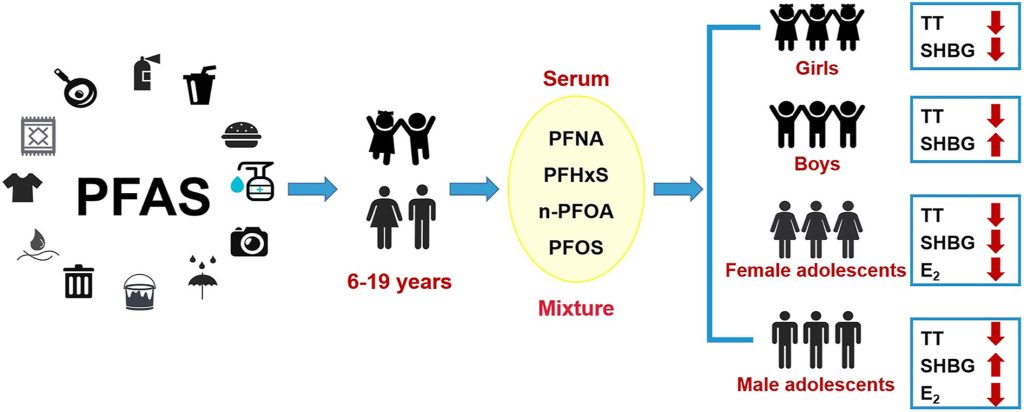
There has been quite a lot of discussion and concern in the past year about PFAS (perfluoroalkyl and polyfluoroalkyl substances) and the harm they can have on adults and children. Since PFAS are found in various everyday household products, like non-stick cookware, food packaging, cleaning products, clothing and makeup, it should be something you are aware of since this can impact your health, and that of your family members. A new study reveals how PFAS can disrupt the balance of sex hormones in children and teens.

The study, titled “Association of perfluoroalkyl and polyfluoroalkyl substances with sex hormones in children and adolescents 6–19 Years of age” by Yue He and colleagues, explored the relationship between exposure to perfluoroalkyl and polyfluoroalkyl substances (PFAS) and the levels of sex hormones in children and adolescents. Researchers used data from the National Health and Nutrition Examination Survey (NHANES) from 2013 to 2016, which included 921 participants aged 6 to 19 years. They assessed the association of individual PFAS or a mixture of PFAS with levels of total testosterone (TT), estradiol (E2), and sex hormone binding globulin (SHBG), which are important for growth and sexual maturity in children and adolescents.
The Study Findings: PFAS are associated with decreased testosterone levels in children and female adolescents, and with increased SHBG levels in male children
The findings suggested that exposure to PFAS is associated with decreased TT levels in children and female adolescents, and with increased SHBG levels in male children. An inverse association was also found between exposure to PFAS and E2 levels in pubertal individuals. Different PFAS showed varied contributions to these associations; for instance, PFOS and PFNA were identified as major contributors in girls and boys, respectively.
It’s important to note that this is just one study. That does not mean you should simply ignore it, but more research needs to be done. Still, it’s no secret that PFAS are harmful to humans. So, it’s something you should be paying attention to.
Did you know? PFAS Stay in the Body for Years
PFAS have a very long elimination half-life in humans. When any substance has a “long elimination of half-life”, this means that it takes a long time for the body to get rid of that substance and eliminate it from the system. Half-life is the time it takes for half of that substance to be eliminated from the body. How long can PFAS stay in the body for? Years! It takes nearly four years for the level in the body to go down by half. Which means, it doesn’t fully leave the body for 8 years. FYI, PFAS leave the body mainly through urine. People who have kidney disease may not excrete as much PFAS from their body through their urine, however, meaning it may stay in the body for even longer. Oh…guess what can cause kidney problems? Yep. PFAS. Epidemiological studies have shown associations between exposure to specific PFAS and a variety of health effects, including altered immune and thyroid function, liver disease, lipid and insulin dysregulation, kidney disease, adverse reproductive and developmental outcomes, and cancer.
What Can You Do to Reduce Your Exposure to PFAS
While it’s impossible to completely avoid PFAS, given how widespread they are, but here are ways to reduce your exposure.
- Check Your Water: If you live in an area known to have PFAS contamination in the water supply, consider having your water tested. If PFAS are found, you might consider installing a water treatment system that is certified to remove PFAS, or use bottled water for drinking and cooking.
- Get rid of your non-stick cookware: Look for pots and pans that are PFAS-free. Instead, cook with stainless steel, cast iron, ceramic coated cookware. If you insist on non-stick cookware, there are some brands that do not contain PFAS, such as Made In Cookware. Anytime you buy any cookware, make sure it says that it is free of PFAS.
- Choose PFAS-Free Products: When buying household items, especially those that are often treated with PFAS, look for products that are specifically labeled as PFAS-free.
- Avoid Microwave Popcorn and Fast Food Packaging: These can often contain PFAS. Pop your own popcorn the old-fashioned way and limit your consumption of fast food to reduce potential exposure from packaging.
- Check Cosmetics Labels: Some cosmetics may contain PFAS. Check labels for ingredients that include the words “fluoro” or “perfluoro.”
- Carefully Dispose of PFAS-containing items: When throwing away items that may contain PFAS, like non-stick cookware or stain-resistant fabrics, consider contacting your local waste facility to see if they have specific procedures for handling PFAS-containing waste.
- Eat Fresh Food: Eating fresh food can help reduce your exposure to PFAS from food packaging.
- Educate Yourself: Stay informed about new research on PFAS and new regulations about their use.
- Advocate for PFAS-Free Products: As a consumer, you have power. Advocate for PFAS-free products and support companies that are committed to phasing out these chemicals.
Leave a Reply